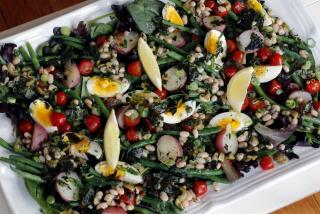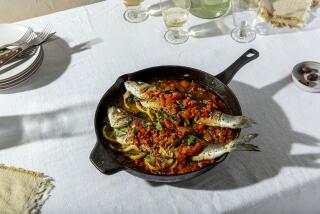Paring down diet can cut need for statins
- Share via
It’s called the portfolio diet. And you won’t find it in any bookstore.
The goal is simple: to see if a “portfolio” of foods, each with some minor cholesterol-lowering benefits, could have a larger, additive effect when eaten together as part of a regular diet. The concept was developed by David Jenkins, professor of nutrition and metabolism at the University of Toronto and a strong proponent of using food to help reduce blood cholesterol levels.
The diet -- which was funded in part by food-industry players Unilever, Loblaw Companies Ltd. (Canada’s largest food distributor) and the Almond Board of California -- won’t be for everyone. Strictly followed, it’s a near-vegan regimen, meaning no meat, eggs, poultry, fish or dairy.
“It’s a real challenge for people to stay on this kind of diet,” says Alice Lichtenstein, professor of nutrition science and policy at Tufts University.
In carefully controlled scientific settings, however, the cholesterol-lowering benefits rivaled statins in cutting blood cholesterol levels. That’s important because millions of people take prescription drugs to control their blood cholesterol levels. Research suggests that about 25% of statin users stop taking their medicine within the first year of treatment, often because of side effects, including muscle pain.
When one dose of statins isn’t enough to lower cholesterol, doctors prescribe more. But there’s a diminishing return: doubling the lowest dose of statins cut blood cholesterol levels by just another 6%.
That’s why the National Heart, Lung and Blood Institute recommends dietary changes as well as medication to help control blood cholesterol levels.
The question is: Can a modified portfolio approach help? To answer that, Jenkins and his team enrolled 66 adults with elevated blood cholesterol in a one-year study of the diet, co-funded by the Canadian government and the food industry.
Participants were instructed to eat a mostly vegetarian diet rich in soy foods, almonds, fruit, vegetables, whole grains and beans as well as some healthy oils and margarine made with plant sterols -- substances that have been proved to lower cholesterol. They were advised to skip fat-free or low-fat dairy products (or to eat these foods no more than twice weekly) and were encouraged to forgo whole eggs, poultry, fish and lean meat.
The study found a direct link between how closely participants followed the portfolio plan and how much their blood levels of low-density lipoprotein (LDL) improved. LDL is directly linked to heart disease risk. Nearly one-third of participants who stuck closest to the plan’s goals lowered their LDL levels by 20% or more, an improvement that rivals the use of low-dose statins.
“There’s no question that you can have very good results with diet,” says Robert Eckel, president of the American Heart Assn. and a faculty member at the University of Colorado Health Sciences Center. What the latest findings suggest, he says, is that altering one’s diet can reduce medication or help prevent the addition of a second cholesterol-lowering drug.
Here’s how you can apply lessons from the study:
* Nuts and healthy margarine proved easiest to add. The researchers used almonds and Take Control spread, because Unilever and the Almond Board helped sponsor the study. But other healthy margarine-like spreads, including Benecol and Smart Balance, can also cut blood cholesterol levels. (To reap cholesterol-lowering benefits, however, the spread must be consumed daily. Other foods that contain the same substances include some orange juices and chocolate.)
Any nuts “that are low in saturated fat would be just fine,” Lichtenstein says. Participants ate about 2 ounces daily, or roughly two handfuls. Just remember that nuts and margarine are high in calories. So if you add them, you’ll need to subtract other foods to avoid weight gain, which also raises cholesterol.
* Reach for okra and eggplant; both are cholesterol-lowering winners. Skip them fried, however, because that adds saturated fat (and when commercially prepared may add unhealthy trans fats).
* Add soy, beans and fiber. Although new findings question soy’s ability to lower cholesterol, it’s still a food low in saturated fat, high in fiber and protein. “Soy can be beneficial when it is used to displace animal foods from the diet, such as hamburger,” Lichtenstein says. Beans, oat bran and psyllium also helped to improve LDL levels in the study.





